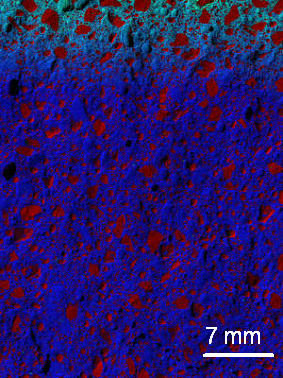
The barely visible blue-green area at the top of this X-ray image of concrete with the NIST nanoadditive shows that very few chloride ions (in green) penetrate into the concrete.
Engineers at the National Institute of Standards and Technology (NIST) are patenting a method that is expected to double the service life of concrete. The key, according to a new paper, is a nano-sized additive that slows down penetration of chloride and sulfate ions from road salt, sea water and soils into the concrete. A reduction in ion transport translates to reductions in both maintenance costs and the catastrophic failure of concrete structures. The new technology could save billions of dollars and many lives.
Concrete has been around since the Romans, and it is time for a makeover. The nation's infrastructure uses concrete for millions of miles of roadways and 600,000 bridges, many of which are in disrepair. In 2007, 25 percent of U.S. bridges were rated as structurally deficient or functionally obsolete, according to the Federal Highway Administration. Damaged infrastructure also directly affects large numbers of Americans' own budgets. The American Society of Civil Engineers estimates that Americans spend $54 billion each year to repair damages caused by poor road conditions.
Infiltrating chloride and sulfate ions cause internal structural damage over time that leads to cracks and weakens the concrete.
Past attempts to improve the lifetime of concrete have focused on producing denser, less porous concretes, but unfortunately these formulations have a greater tendency to crack. NIST engineers took a different approach, setting out to double the material's lifetime with a project called viscosity enhancers reducing diffusion in concrete technology (VERDICT). Rather than change the size and density of the pores in concrete, they reasoned, it would be better to change the viscosity of the solution in the concrete at the microscale to reduce the speed at which chlorides and sulfates enter the concrete. "Swimming through a pool of honey takes longer than making it through a pool of water," engineer Dale Bentz says.
They were inspired by additives the food processing industry uses to thicken food and even tested out a popular additive called xanthum gum that thickens salad dressings and sauces and gives ice cream its texture.
Studying a variety of additives, engineers determined that the size of the additive's molecule was critical to serving as a diffusion barrier. Larger molecules such as cellulose ether and xanthum gum increased viscosity, but did not cut diffusion rates. Smaller molecules—less than 100 nanometers—slowed ion diffusion. Bentz explains, "When additive molecules are large but present in a low concentration, it is easy for the chloride ions to go around them, but when you have a higher concentration of smaller molecules increasing the solution viscosity, it is more effective in impeding diffusion of the ions."
The NIST researchers have demonstrated that the additives can be blended directly into the concrete with current chemical admixtures, but that even better performance is achieved when the additives are mixed into the concrete by saturating absorbant, lightweight sand. Research continues on other materials as engineers seek to improve this finding by reducing the concentration and cost of the additive necessary to double the concrete's service life.
A non-provisional patent application was filed in September, and the technology is now available for licensing from the U.S. government; the NIST Office of Technology Partnerships can be contacted for further details (Contact: Terry Lynch, terry.lynch [at] nist.gov (terry[dot]lynch[at]nist[dot]gov), (301) 975-2691).
D.P. Bentz, M.A. Peltz, K.A. Snyder and J.M. Davis. VERDICT: Viscosity Enhancers Reducing Diffusion in Concrete Technology. Concrete International. 31 (1), 31-36, January 2009.

